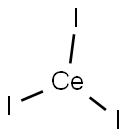Cerium(III) bromide hydrate
- CAS NO.:14457-87-5
- Empirical Formula: Br3Ce
- Molecular Weight: 379.83
- MDL number: MFCD06496250
- EINECS: 238-447-0
- SAFETY DATA SHEET (SDS)
- Update Date: 2025-01-27 09:38:02

What is Cerium(III) bromide hydrate?
Description
Cerium(III) bromide hydrate is a compound with the molecular formula CeBr3 · H2O. It is composed of colorless needle-shaped crystals that are prone to deliquescence. Cerium(III) bromide is highly soluble in water and ethanol, and is also soluble in acetone. When exposed to heat, it decomposes. The solution of Cerium(III) bromide is neutral to Methyl orange solution, but acidic to litmus. It is recommended to store it in sealed containers.
Chemical properties
orange powder(s); hygroscopic [STR93]
The Uses of Cerium(III) bromide hydrate
Cerium(III) bromide hydrate is used in the security, medical imaging, and geophysics detectors, γ-ray scintillation detector in nuclear non-proliferation testing, medical imaging, environmental remediation, and oil exploration.
Preparation
Preparation of Cerium(III) bromide: Anhydrous Cerium(III) bromide can be synthesized by either heating Cerium(IV) oxide and Hydrogen bromide to red heat or by reacting trivalent Cerium oxalate with dry Hydrogen bromide at high temperatures.
Properties of Cerium(III) bromide hydrate
| Melting point: | 730 °C(lit.) |
| Boiling point: | 1560℃ |
| Density | 5.18 |
| storage temp. | under inert gas (nitrogen or Argon) at 2-8°C |
| solubility | soluble in H2O |
| form | powder |
| color | White to pale gray |
| Water Solubility | Soluble in water. |
| Sensitive | Hygroscopic |
| Merck | 14,1995 |
| Stability: | hygroscopic |
| CAS DataBase Reference | 14457-87-5(CAS DataBase Reference) |
| EPA Substance Registry System | Cerium bromide (CeBr3) (14457-87-5) |
Safety information for Cerium(III) bromide hydrate
| Signal word | Warning |
| Pictogram(s) |
 Exclamation Mark Irritant GHS07 |
| GHS Hazard Statements |
H315:Skin corrosion/irritation H319:Serious eye damage/eye irritation H335:Specific target organ toxicity, single exposure;Respiratory tract irritation |
| Precautionary Statement Codes |
P261:Avoid breathing dust/fume/gas/mist/vapours/spray. P264:Wash hands thoroughly after handling. P264:Wash skin thouroughly after handling. P271:Use only outdoors or in a well-ventilated area. P280:Wear protective gloves/protective clothing/eye protection/face protection. P302+P352:IF ON SKIN: wash with plenty of soap and water. P305+P351+P338:IF IN EYES: Rinse cautiously with water for several minutes. Remove contact lenses, if present and easy to do. Continuerinsing. |
Computed Descriptors for Cerium(III) bromide hydrate
New Products
3-Iodophenylacetic acid 3-Pyridineacetonitrile, α-hydroxy- 2-Propanamine, 1-chloro-, hydrochloride (9CI) 3-(hexyloxy)-4-(pyridin-3-yl)-1,2,5-thiadiazole 2-Hexyn-1-ol Dibenzo-18-crown-6 Nickel(II) perchlorate hexahydrate, 98% 4-Bromophenylacetonitrile, 95% 3-Bromo-4-fluoroaniline, 97% Sodium tetraborate decahydrate, 98% Palladium(II) acetate, trimer, Pd 99% 4-Bromo-2-chlorotoluene, 97% N N Dimethylformamide Dimethyl Acetal (Dmf Dma) 2,3-Dichloro Benzoyl Cyanide [Side Chain] Bis(2-Chloroethyl) Amine Hydrochloride L-Glutamic Acid Diethyl Ester Hydrochloride 5-(Difluoromethoxy)-2-Mercaptobenzimidazole 1-Ethyl-3-(3-Dimethylaminopropyl)-Carbodiimide Hydrochloride [EDC Hcl] 1,4-Napthoquinone Bromoiodomethane Sodium Bicarbonate Methylene Dichloride (MDC) Ethyl Acetate Indole-3-Carbinol (I3C)Related products of tetrahydrofuran








You may like
-
 Cerium(III) bromide, Ultra dry CAS 14457-87-5View Details
Cerium(III) bromide, Ultra dry CAS 14457-87-5View Details
14457-87-5 -
 Cerium(III) bromide, Ultra dry CAS 14457-87-5View Details
Cerium(III) bromide, Ultra dry CAS 14457-87-5View Details
14457-87-5 -
 Cerium(III) bromide, Ultra dry CAS 14457-87-5View Details
Cerium(III) bromide, Ultra dry CAS 14457-87-5View Details
14457-87-5 -
 Cerium(III) bromide, anhydrous, beads, -10 mesh, 99.99% CAS 14457-87-5View Details
Cerium(III) bromide, anhydrous, beads, -10 mesh, 99.99% CAS 14457-87-5View Details
14457-87-5 -
 Cerium(III) bromide anhydrous CAS 14457-87-5View Details
Cerium(III) bromide anhydrous CAS 14457-87-5View Details
14457-87-5 -
 Cerium(III) bromide CAS 14457-87-5View Details
Cerium(III) bromide CAS 14457-87-5View Details
14457-87-5 -
 Cyclohexane, (2-propynyloxy)- 67967-07-1 98+View Details
Cyclohexane, (2-propynyloxy)- 67967-07-1 98+View Details
67967-07-1 -
 132945-75-6 (S)-1-Boc-3-methanesulfonyloxy-pyrrolidine 98+View Details
132945-75-6 (S)-1-Boc-3-methanesulfonyloxy-pyrrolidine 98+View Details
132945-75-6
